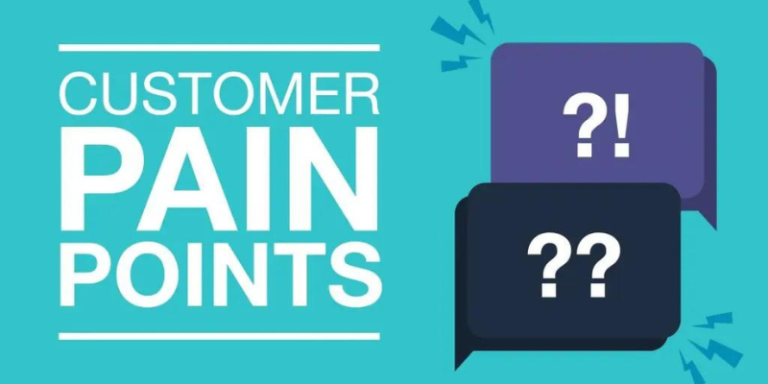Customer pain points are the specific problems, challenges, or frustrations that customers experience during their interaction with a product, service, or brand (Brown, 2019). Identifying these pain points is crucial for businesses as it allows them to understand the areas where their customers are dissatisfied or facing difficulties (Bhalla, 2020). Addressing these pain points can lead to improved customer satisfaction, loyalty, and retention (Forbes, 2018).
Some Common Customer Pain Points Across Industries Include:
1.0 Poor Customer Service: Long wait times, unresponsive support, or unfriendly interactions can frustrate customers (Tuten & Solomon, 2018).
2.0 Complexity: Products or services that are difficult to understand, use, or navigate can deter customers (Fisher & Pride, 2020).
3.0 Lack of Personalisation: Customers often seek personalised experiences tailored to their preferences and needs. Generic or irrelevant offerings can lead to dissatisfaction (Kumar, 2019).
4.0 High Prices: Customers may perceive products or services as overpriced, especially if they don’t see sufficient value in return (Solomon et al., 2020).
5.0 Quality Issues: Products that are unreliable, prone to defects, or don’t meet expectations can result in dissatisfaction and returns (Pride & Ferrell, 2021).
6.0 Inconvenient Buying Process: Complicated checkout processes, unclear return policies, or limited payment options can deter customers from making purchases (Meyer & Schwager, 2007).
7.0 Poor Product Fit: Customers may encounter issues with products not meeting their specific needs or expectations, leading to frustration (Kotler et al., 2016).
8.0 Inadequate Communication: Lack of timely updates, unclear instructions, or difficulty reaching customer support can lead to dissatisfaction (Keller, 2013).
9.0 Limited Availability: Products or services being out of stock or unavailable when needed can result in frustration and lost sales opportunities (Hollensen, 2019).
10.0 Security Concerns: Customers may have concerns about the security of their personal information when interacting with a business, especially during online transactions (Strauss & Frost, 2017).
By addressing these pain points, businesses can enhance the overall customer experience, build stronger relationships with their customers, and gain a competitive edge in the market (Kotler et al., 2020).
Here are Several Strategies to Effectively Tackle Customer Pain Points:
1.0 Listening to Customer Feedback: Actively listen to feedback from customers through various channels like surveys, reviews, and direct communication (Rajamanickam, 2021). Analyse recurring themes or complaints to identify common pain points and prioritise them for resolution.
2.0 Empathy and Understanding: Show empathy towards customers’ frustrations and understand their perspectives (Rajamanickam, 2021). Acknowledge their concerns genuinely and express a sincere interest in resolving their issues.
3.0 Improving Customer Service: Enhance customer service processes to deliver prompt, helpful, and personalised support (Daskal, 2020). Train staff to handle inquiries and complaints effectively, ensuring customers feel valued and respected throughout their interactions.
4.0 Simplifying Processes: Streamline complex processes such as purchasing, returns, and support to make them more intuitive and user-friendly (Daskal, 2020). Eliminate unnecessary steps and reduce confusion to improve the overall customer experience.
5.0 Personalisation: Tailor products, services, and communications to match individual customer preferences and needs (Rajamanickam, 2021). Utilise data analytics and customer insights to provide personalised recommendations and offers.
6.0 Addressing Pricing Concerns: Review pricing strategies to ensure customers perceive fair value for products or services received (Rajamanickam, 2021). Offer discounts, promotions, or loyalty programmes to ease pricing concerns and encourage repeat purchases.
7.0 Focusing on Quality: Invest in product development and quality control to deliver reliable, high-quality offerings (Daskal, 2020). Address product defects promptly to maintain customer satisfaction and loyalty.
8.0 Communication and Transparency: Keep customers informed about updates, changes, or issues related to products or services (Rajamanickam, 2021). Practise transparency regarding policies, processes, and commitments to build trust and credibility.
9.0 Improving Availability: Optimise inventory management and distribution processes to ensure products or services are readily available when needed (Daskal, 2020). Minimise out-of-stock situations and provide alternative options when necessary.
10.0 Addressing Security Concerns: Implement robust security measures to protect customer data and ensure a safe online shopping experience (Rajamanickam, 2021). Communicate a commitment to security and privacy to alleviate customer concerns.
By addressing customer pain points proactively and effectively, businesses can enhance customer satisfaction, loyalty, and retention, ultimately driving growth and success (Daskal, 2020).
References:
Bhalla, R. (2020) Identifying customer pain points. Medium. Available at: https://medium.com/@rbhalla/identifying-customer-pain-points-ec8efcebc3b3 [Accessed on 11 May 2024].
Brown, J. (2019) Customer pain points: What they are and how to identify them. Zendesk. Available at: https://www.zendesk.com/blog/customer-pain-points/. [Accessed on 11 May 2024].
Daskal, L. (2020) How to Identify and Address Your Customers’ Pain Points. Inc. Available at: https://www.inc.com/lolly-daskal/how-to-identify-and-address-your-customers-pain-points.html. [Accessed on 11 May 2024].
Forbes. (2018) The importance of addressing customer pain points. Forbes. Available at: https://www.forbes.com/sites/forbescommunicationscouncil/2018/03/15/the-importance-of-addressing-customer-pain-points/?sh=19f16e1f5e0f. [Accessed on 11 May 2024].
Hollensen, S. (2019) Global marketing. Pearson Education.
Fisher, K., & Pride, W. M. (2020) Marketing principles. Cengage Learning.
Kumar, V. (2019) Marketing research. Wiley.
Meyer, C., & Schwager, A. (2007) Understanding customer experience. Harvard Business Review Press.
Keller, K. L. (2013) Strategic brand management. Pearson Education.
Kotler, P., et al. (2016) Marketing management. Pearson Education.
Kotler, P., et al. (2020) Marketing 4.0. Wiley.
Pride, W. M., & Ferrell, O. C. (2021) Foundations of marketing. Cengage Learning.
Rajamanickam, A. (2021) 10 Ways to Address Customer Pain Points for Business Growth. Business 2 Community. Available at: https://www.business2community.com/customer-experience/10-ways-to-address-customer-pain-points-for-business-growth-02466739. [Accessed on 11 May 2024].
Solomon, M. R., et al. (2020) Consumer behaviour: Buying, having, and being. Pearson.
Strauss, J., & Frost, R. D. (2017) E-marketing. Routledge.













